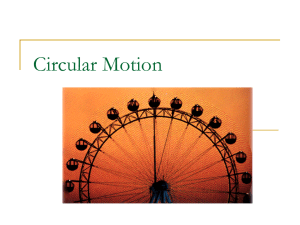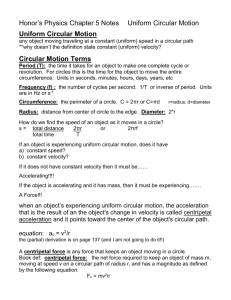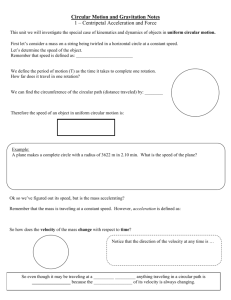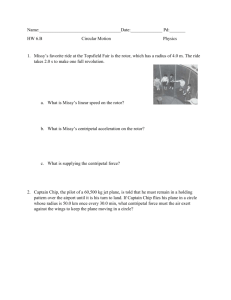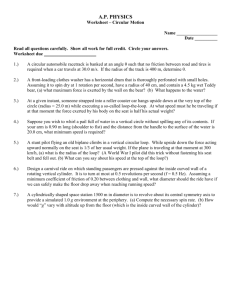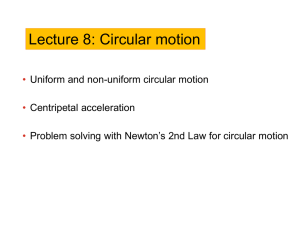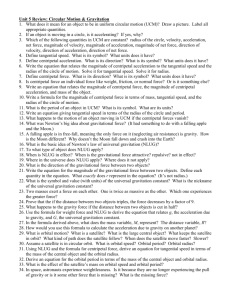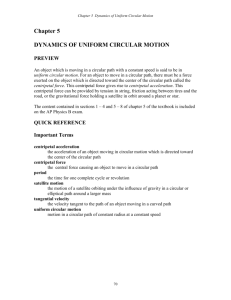Work, Energy and Momentum Notes
advertisement
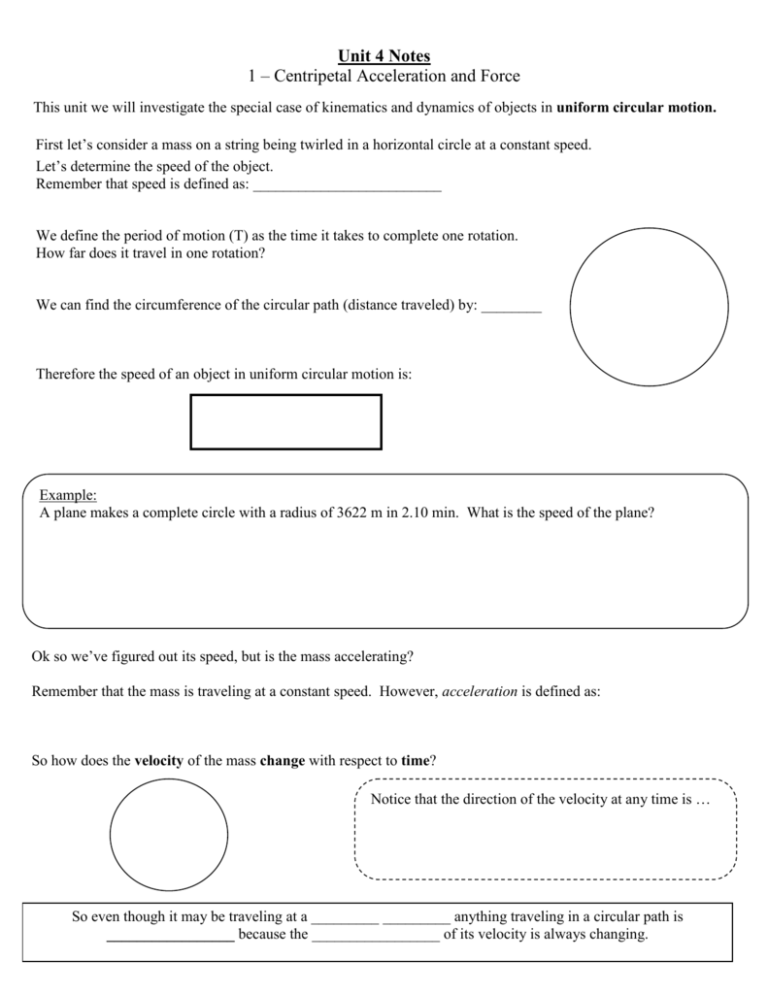
Unit 4 Notes 1 – Centripetal Acceleration and Force This unit we will investigate the special case of kinematics and dynamics of objects in uniform circular motion. First let’s consider a mass on a string being twirled in a horizontal circle at a constant speed. Let’s determine the speed of the object. Remember that speed is defined as: _________________________ We define the period of motion (T) as the time it takes to complete one rotation. How far does it travel in one rotation? We can find the circumference of the circular path (distance traveled) by: ________ Therefore the speed of an object in uniform circular motion is: Example: A plane makes a complete circle with a radius of 3622 m in 2.10 min. What is the speed of the plane? Ok so we’ve figured out its speed, but is the mass accelerating? Remember that the mass is traveling at a constant speed. However, acceleration is defined as: So how does the velocity of the mass change with respect to time? Notice that the direction of the velocity at any time is … So even though it may be traveling at a _________ _________ anything traveling in a circular path is _________________ because the _________________ of its velocity is always changing. The acceleration of an object in uniform circular motion is: Let’s do a quick derivation of this formula: It is worth noting from the above derivation that the direction of the change in velocity is always.... Therefore the acceleration of an object in circular motion is always towards the… This is the definition of centripetal, which means: center-seeking. Whenever an object is accelerated there must be a… This force is known as centripetal force, Fc. This is not a new force, it is simply the net force that accelerates an object towards the center of its circular path. Examples: 1) A mass is twirled in a circle at the end of a string, the centripetal force is provided by _______________________________ 2) When a car rounds a corner on a highway, the centripetal force is provided by _______________________________ 3) When the Moon orbits the Earth, the centripetal force is provided by _______________________________ Newton’s Second Law we can help us to determine a formula for centripetal force: Example: a. A skater travels at 2.0 m/s in a circle of radius 4.0 m. What is her centripetal acceleration? Example: A car traveling at 14 m/s goes around an unbanked curve in the road that has a radius of 96 m. What is its centripetal acceleration? b. What is the centripetal acceleration of the Moon towards Earth? What is the minimum coefficient of friction between the road and the car’s tires? One last note on a little thing called centrifugal force. While centripetal means center-___________________ centrifugal means center- _______________________. An inertial frame of reference is a one where Newton’s Law’s ________ ____________. In an inertial frame of reference, centrifugal force is actually an apparent force - it does not exist. It is simply the apparent force that causes a revolving or rotating object to move in a straight line. However, Newton’s First Law tells us that we do not need a force to keep an object moving in a straight line, you only need a force to deflect an object from moving in a straight line. Example: When riding in the backseat of a car that is turning a corner, you slide across the seat, seeming to accelerate outwards, away from the center of the turning circle. Explain why the force in this case is actually working towards the center of the turn and not outwards. Unit 4 Notes 2 – More Centripetal Problems We have already seen the forces acting on a mass moving in a horizontal circle, now let’s see how this differs from a mass moving in a vertical circle. Draw the forces acting on a mass on a string being spun in a vertical circle at the top and bottom of its path. As with any object moving in a circle there is a ______ _____________ acting on it. This net force is a centripetal force. Notice that at the top of its arc the centripetal force (or net force) is: Also at the bottom of the arc the centripetal force is: Example: A 1.7 kg object is swung from the end of a 0.60 m string in a vertical circle. If the time of one revolution is 1.1 s, what is the tension in the string: a) at the top? b) at the bottom? Now suppose the mass is spun with just enough speed to keep it moving in a circular path. What is the tension in the string at the top? We say that the mass at the peak of the arc is weightless, because the net force working on it is only ______________________. This is the same as an object in total free fall. Example: An object is swung in a vertical circle with a radius of 0.75 m. What is the minimum speed of the object at the top of the motion for the object to remain in circular motion? Notice that the velocity of the object… it depends only on… For the special case of finding the minimum speed of an object at the top of its circular arc we can use the equation: Banked Curves (and other 2-D Problems): When cars travel at high speeds on highways, they do not rely solely on friction to keep the cars from sliding off the road. A greater centripetal force can exist if the turn is banked. Consider a car traveling at a constant speed around a frictionless banked corner. On a frictionless corner only _________ and ________ act on the car. Note that in this case FN is larger because it both: (1) (2) The sum of FN and Fg must equal _____________________ Example Calculate the angle at which a frictionless curve must be banked if a car is to round it safely at a speed of 22 m/s if its radius is 475 m. Example A 0.25 kg toy plane is attached to a string so that it flies in a horizontal circle with a radius of 0.80 m.. The string makes a 28o angle to the vertical. What is its period of rotation? 28o Unit 4 Notes 3 – Gravitation Newton discovered that gravity attracts any two objects depending on their ____________________ and their _________________________. Fg is proportional to the two masses Fg α Fg is inversely proportional to the square of the distance between their centers of mass Fg α or Where: Example Calculate the force of gravity between two 75 kg students if their centers of mass are 0.95 m apart. Common Question Alert!!! You will often see problems that ask something like this… A satellite weighs 9000 N on Earth’s surface. How much does it weigh if its mass is tripled and its orbital radius is doubled? While we’re at it, let’s make sure we clear up another common misconception: mass vs. weight. Mass: Weight: Satellites in Orbit A satellite of the Earth, such as the moon, is constantly falling. But it does not fall towards the Earth, rather it falls around the Earth. Just as if you were in an elevator that was falling towards the Earth you would feel weightless if you were on an artificial satellite falling around the Earth. Consider the Moon: Example: A 4500 kg Earth satellite has an orbital radius of 8.50x107 m. At what speed does it travel? Unit 4 Notes 4 – Gravitational Fields Scientists had difficulty explaining how two objects that are not in contact can exert a force on one another. In order to help conceptualize how this can occur, we had invented the idea of FIELDS. To help imagine how these fields work, consider a campfire. It seems as though the fire is emitting a heat field. As you approach the fire the … A field is defined as… As you increase the size of the fire the … Just like this so-called heat field, gravitational fields surround any mass. Fields can be described as either vector or scalar. While heat is measured by temperature (a scalar) its field is also scalar. Gravitational fields are force fields and as such are ______________. Vector fields, like vector quantities, are represented by arrows. In this case, the density of the arrows represents the magnitude of the field strength… We are already quite familiar with gravitational field strength by its other name: ______________________. Recall that: Fg = mg Therefore Where g = acceleration due to gravity = gravitational field strength = 9.80 m/s2 near Earth’s surface This formula works fine if we stay put on Earth, but it falls way short once we leave Terra Firma because… However, we can derive a more useful formula: Example: What is the gravitational field strength on the surface of the Moon? Example: A satellite orbits the Earth at a radius of 2.20x107 m. What is its orbital period? mmoon = 7.35x1022 kg rmoon = 1.74x106 m Geosynchronous Orbit The orbital speed of a satellite will depend on the strength of gravitational field at the orbital radius. Consider the following situations. Which identical satellite will be travelling faster in each case? Why? a) Satellite A orbits the Earth at twice the orbital radius of Satellite B. b) Satellite A orbits the Sun at the same orbital radius that Satellite B orbits the Earth. The orbital period of the satellite depends only on the mass of the planet and the orbital radius of the satellite. It stands to reason therefore that at a certain orbital distance the orbital period will match the rotational period of the planet. Such a satellite is said to be in geosynchronous (or geostationary) orbit. Example: Find the orbital radius of a satellite that is geostationary above Earth’s equator. What is the speed of this satellite?

